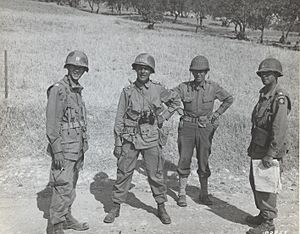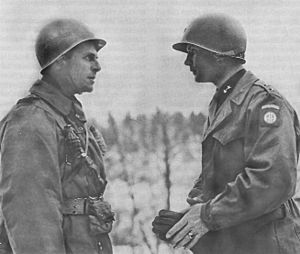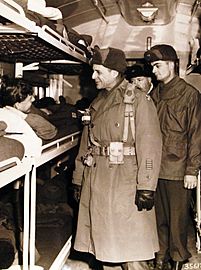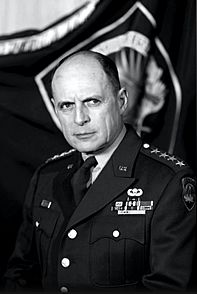Matthew Ridgway facts for kids
Quick facts for kids
Matthew Ridgway
|
|
|---|---|
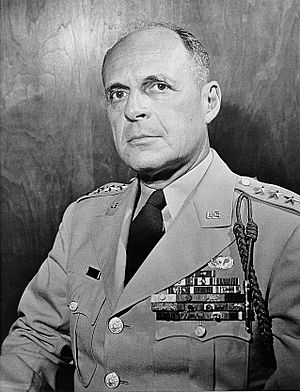
Ridgway in 1951
|
|
| Born | March 3, 1895 Fort Monroe, Virginia, United States |
| Died | July 26, 1993 (aged 98) Fox Chapel, Pennsylvania, United States |
| Buried |
Arlington National Cemetery, Virginia, United States
(38°52′37″N 77°04′14″W / 38.87702°N 77.07047°W) |
| Allegiance | United States |
| Service/ |
United States Army |
| Years of service | 1917–1955 |
| Rank | General |
| Service number | 0-5264 |
| Unit | Infantry Branch |
| Commands held | Chief of Staff of the United States Army Supreme Allied Commander Europe Supreme Commander for the Allied Powers United Nations Command Eighth Army Caribbean Command XVIII Airborne Corps 82nd Airborne Division 82nd Infantry Division 15th Infantry Regiment |
| Battles/wars | Mexican Border Service World War I Banana Wars
|
| Awards | Distinguished Service Cross (2) Army Distinguished Service Medal (4) Silver Star (2) Legion of Merit (2) Bronze Star Medal w/ Valor Device (2) Purple Heart Presidential Medal of Freedom Congressional Gold Medal |
| Signature |  |
General Matthew Bunker Ridgway (March 3, 1895 – July 26, 1993) was a top officer in the United States Army. He served as the main commander for NATO forces in Europe and later as the head of the U.S. Army.
Ridgway was a key leader in World War II. He led the famous 82nd Airborne Division in major battles in Sicily, Italy, and Normandy. He also commanded the XVIII Airborne Corps during the Battle of the Bulge. After the war, he became famous for turning around the United Nations' efforts during the Korean War. Many historians say he helped win the war for the UN side. He also convinced President Dwight D. Eisenhower not to send U.S. troops into the First Indochina War. This decision delayed the Vietnam War for more than ten years. He received the Presidential Medal of Freedom in 1986 for his long and important military career. Ridgway passed away in 1993 at the age of 98.
Contents
Matthew Ridgway's Early Life and Schooling
Matthew Ridgway was born on March 3, 1895, in Fort Monroe, Virginia. His father, Thomas Ridgway, was an artillery officer. Matthew grew up on different military bases. He later said his first memories were of "guns and marching men."
In 1912, he graduated from The English High School in Boston. He decided to apply to the United States Military Academy at West Point. He wanted to make his father, who also went to West Point, proud. He failed the entrance exam the first time because he wasn't good at mathematics. But he studied hard and passed the second time. At West Point, he managed the football team. He graduated on April 20, 1917, just after the U.S. entered World War I. He became a second lieutenant in the Infantry Branch of the United States Army. Many of his classmates also became generals, like J. Lawton Collins and Mark W. Clark.
Matthew Ridgway's Military Career
World War I Service
Ridgway started his army career during World War I. He was sent to the border with Mexico with the 3rd Infantry Regiment. Then he became a Spanish instructor at West Point. He was sad he didn't get to fight in the war. He felt that soldiers who didn't fight would be "ruined."
Between the World Wars
From 1924 to 1925, Ridgway went to a special course for officers in Fort Benning, Georgia. After that, he led a company in the 15th Infantry Regiment in China. He also went to Nicaragua in 1927. There, he helped supervise free elections.
In 1930, Ridgway became an advisor in the Philippines. He continued his military education, graduating from the United States Army Command and General Staff College in 1935. He also graduated from the United States Army War College in 1937. During the 1930s, he held several important staff positions. General George C. Marshall, the head of the U.S. Army, assigned Ridgway to the War Plans Division in 1939. This was right after World War II started in Europe.
He was promoted to lieutenant colonel in July 1940. He stayed in the War Plans Division until January 1942. He was promoted to brigadier general that month.
World War II Leadership
After the Japanese attack on Pearl Harbor in December 1941, the U.S. entered World War II. Ridgway was quickly promoted from lieutenant colonel to major general in just four months. In February 1942, he became the Assistant Division Commander of the 82nd Infantry Division. This division was just being formed.
The division was led by Major General Omar Bradley, whom Ridgway respected. They trained thousands of soldiers together. In August, Ridgway was promoted to major general and took command of the 82nd Division. The 82nd was chosen to become one of the army's new airborne divisions. This meant converting an entire infantry division to airborne status. It required a lot of training and testing. So, on August 15, 1942, it became the 82nd Airborne Division.
Ridgway helped plan the airborne part of the Allied invasion of Sicily. This invasion happened in July 1943. His 505th Parachute Infantry Regiment led the way. The 82nd faced many challenges in Sicily and had heavy losses. Ridgway reported to Lieutenant General George S. Patton that he had fewer than 400 paratroopers under his control. More than 5,300 had jumped into Sicily.
During the plan for the invasion of mainland Italy, the 82nd was supposed to take Rome. Ridgway strongly disagreed with this plan. He thought it was too risky. The plan was canceled just hours before it was supposed to start. The 82nd did play a big part in the invasion of Italy at Salerno in September. Their parachute drop helped stop the Allies from being pushed back into the sea. The division then moved to Naples and later to Northern Ireland.
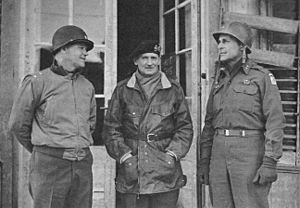
In late 1943 and early 1944, Ridgway helped plan the airborne operations for Operation Overlord. This was the code name for the Allied invasion of Normandy. He successfully argued for more paratroopers in the two American airborne divisions. In the Battle of Normandy, he jumped with his troops. They fought for 33 days. The 82nd Airborne Division suffered many casualties.
In August 1944, Ridgway took command of the XVIII Airborne Corps. The 82nd Airborne Division was then led by Brigadier General James M. Gavin. Ridgway's corps helped stop German troops during the Battle of the Bulge in December. In March 1945, he led the corps into Germany during Operation Varsity. This was an airborne attack. He was wounded in the shoulder on March 24, 1945. He led the corps in the Western Allied invasion of Germany. On June 4, 1945, he was promoted to lieutenant general.

At the end of the war, Ridgway was on a plane heading to the Pacific theater. He was going to work under General of the Army Douglas MacArthur. Ridgway spoke highly of British Field Marshal Sir Bernard Montgomery. He said his time serving under Montgomery was "most satisfying."
After World War II
Ridgway commanded forces in Luzon until October 1945. Then, he led U.S. forces in the Mediterranean Theater. From 1946 to 1948, he worked for the United Nations. In 1948, he took charge of the Caribbean Command. In 1949, he became Deputy Chief of Staff for Administration.
In December 1947, Ridgway married Mary Princess "Penny" Anthony Long. They were married for 46 years. Their only child, Matthew Bunker Ridgway, Jr., was born in 1949. Sadly, his son died in an accident in 1971.
Korean War Leadership
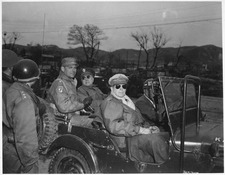
Ridgway's most important job came in 1950. He was assigned to lead the Eighth United States Army in South Korea. This was after North Korea invaded in June. When Ridgway took command, the army was retreating. They had been pushed back by a huge Chinese advance.
Ridgway was very successful in boosting the army's spirits. He was not afraid of General of the Army Douglas MacArthur, who was the overall commander. MacArthur gave Ridgway a lot of freedom to make decisions. Ridgway asked if he could attack if the situation was good. MacArthur told him, "Eighth Army is yours, Matt. Do what you think best."
Ridgway quickly worked to restore soldiers' confidence. He changed the command structure. He made sure officers spent more time on the front lines. He also used a lot of artillery. China's soldiers suffered huge losses from the artillery fire. Under Ridgway's leadership, the Chinese attack slowed down and stopped. This happened at the battles of Chipyong-ni and Wonju. He then led his troops in a counter-attack in early 1951.
When General MacArthur was removed from command, Ridgway was promoted to full general. He took command of all UN forces in Korea. He also oversaw the desegregation of U.S. Army units. This helped the entire army become integrated. Ridgway also became the military governor of Japan. He oversaw Japan becoming an independent country again in 1952.
Supreme Allied Commander in Europe
In May 1952, Ridgway took over from General Dwight D. Eisenhower. He became the Supreme Allied Commander Europe (SACEUR) for NATO. In this role, Ridgway worked to create a strong command structure. He expanded forces and improved training. He was known for telling the truth, even if it wasn't popular. General Omar Bradley said Ridgway had brought NATO to a "realistic phase."
Ridgway also asked for German officers convicted of war crimes to be pardoned. He felt his "honor as a soldier" required this. He said he had given similar orders in Korea.
Chief of Staff of the U.S. Army
On August 17, 1953, Ridgway became the Chief of Staff of the United States Army. After Eisenhower became president, he asked Ridgway about sending U.S. troops to Vietnam. Ridgway explained how much effort and how many troops would be needed. This made the President decide not to intervene.
Ridgway believed that air power and nuclear bombs did not mean ground forces were less important. He worried that reducing the army's size would make it too weak. He often disagreed with Eisenhower on this. Ridgway was part of a group in the army that didn't want to fight another land war in Asia. They saw the Korean War as a difficult experience.
In 1954, Ridgway strongly opposed a plan to use tactical nuclear weapons in Vietnam. This plan was called Operation Vulture. It aimed to help the French at the Battle of Dien Bien Phu. Ridgway argued that air power alone would not be enough. He said it would take seven American infantry divisions to save the French. He also predicted that if the U.S. intervened, China would too. Ridgway believed fighting another war against China in Asia would be a costly mistake. He felt Europe was much more important than Vietnam.
President Eisenhower was hesitant. He felt bad about the atomic bombings in 1945. He finally agreed to the plan only if Congress approved and Great Britain joined. Congress was unsure, and British Prime Minister Winston Churchill refused to join. On May 7, 1954, the French forces at Dien Bien Phu surrendered.
President Eisenhower allowed Ridgway to stay past the usual retirement age. But disagreements with the government kept Ridgway from serving a second term. He retired from the army on June 30, 1955. He was replaced by General Maxwell D. Taylor. Even after retiring, Ridgway often criticized President Eisenhower.
The "Wise Men" Group
In November 1967, Ridgway joined a group called the "Wise Men." This group of retired leaders advised President Lyndon B. Johnson on the Vietnam War. In early 1968, Ridgway, along with other generals, said they were against bombing North Vietnam. They felt South Vietnam was not worth the effort.
After the Tet Offensive, President Johnson faced a crisis. He was unsure whether to continue fighting or seek peace. General Earle Wheeler tried to force Johnson to keep fighting. He asked for 206,000 more troops for Vietnam. This would have required calling up reserves and the National Guard. This would disrupt the economy and make it harder to seek peace.
Clark Clifford, the new Defense Secretary, met with Ridgway and General James M. Gavin. Both generals told Clifford that winning in Vietnam was impossible. They advised him to push Johnson for a diplomatic solution. This advice helped change Clifford's mind.
On March 25, 1968, Johnson called a meeting of the "Wise Men." The next day, most of them advised Johnson that victory was impossible. They told him to seek peace talks. This advice was key in convincing Johnson. On March 31, 1968, Johnson announced he would seek peace talks. He also said he would not run for president again. Ridgway's status as a war hero made his advice very powerful.
Matthew Ridgway's Personal Life
In 1917, Matthew Ridgway married Julia Caroline Blount. They had two daughters, Constance and Shirley, before divorcing in 1930. He then married Margaret Wilson Dabney. He adopted her daughter, Virginia Ann. They divorced in 1947. Later that year, he married Mary Princess Anthony Long, known as "Penny." They had a son, Matthew Jr., who died in an accident in 1971.
After retiring, Ridgway stayed active. He moved to Fox Chapel, Pennsylvania. He became chairman of the board of trustees for the Mellon Institute. He also joined the board of directors for Gulf Oil Corporation. In 1956, he published his autobiography, Soldier: The Memoirs of Matthew B. Ridgway. In 1967, he wrote The Korean War.
Ridgway continued to speak out for a strong military. He gave many speeches and wrote articles. In 1968, he met with President Johnson and Vice President Hubert Humphrey. He advised against getting deeper into Vietnam. He also advised against using force in the Pueblo Incident. He believed military goals should always support national interests.
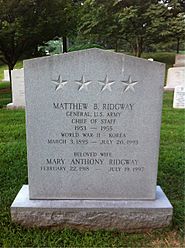
On May 5, 1985, Ridgway was with President Ronald Reagan at a cemetery in Germany. A former German pilot, Johannes Steinhoff, shook his hand. This was a moment of peace between former enemies.
Ridgway died at his home in Pennsylvania in July 1993. He was 98 years old. He was buried at Arlington National Cemetery. General Colin Powell gave a eulogy at his grave. He said, "No soldier ever performed his duty better than this man."
Matthew Ridgway's Legacy
Ridgway was known as an amazing leader. He earned respect from everyone. General Omar Bradley called Ridgway's work in the Korean War "the greatest feat of personal leadership in the history of the Army." A soldier in Normandy remembered Ridgway being right where the fighting was heaviest. He said it was "truly an inspirational effort."
During the Battle of the Bulge, Ridgway told his officers, "The situation is normal and completely satisfactory." He said the enemy had used all their forces. He promised his corps would stop them and "smash him."
Ridgway believed leadership had three main parts: character, courage, and competence. He said character was the "bedrock." This included self-discipline, loyalty, and admitting mistakes. Courage meant both physical bravery and moral strength. Competence meant being physically fit and being close to your soldiers. It also meant communicating clearly and treating them fairly.
Major Assignments
- War Plans Division – December 24, 1941 to February 19, 1942
- Assistant Division Commander, 82nd Infantry Division – February 19, 1942 to June 26, 1942
- Commander, 82nd Airborne Division – June 26, 1942 to August 27, 1944
- Commander, XVIII Airborne Corps – August 27, 1944 to October 1945
- Deputy Supreme Allied Commander, Mediterranean – October 1945 to 1946
- US Army Representative to the Military Staff Committee of the United Nations – 1946 to 1948
- Commander, United States Caribbean Command – 1948 to 1949
- Deputy Chief of Staff for Administration – 1949 to December 24, 1950
- Commander, Eighth United States Army – December 26, 1950 to April 11, 1951
- Commander, United Nations Command Korea – April 11, 1951 to May 12, 1952
- Supreme Commander for the Allied Powers (SCAP) – April 11, 1951 to April 28, 1952
- Commander in Chief, United States Far East Command – April 11, 1951 to May 12, 1952
- Supreme Allied Commander Europe for NATO – May 30, 1952 to July 11, 1953
- Commander, United States Army European Command (EUCOM) – May 30, 1952 to August 1, 1952
- Commander in Chief, United States European Command (USEUCOM) – August 1, 1952 to July 11, 1953
- Chief of Staff of the United States Army – August 17, 1953 to June 30, 1955
Orders, Decorations, Medals, and Badges
United States Badges, Decorations and Medals
| Army Distinguished Service Cross with oak leaf cluster | |
| Army Distinguished Service Medal with four oak leaf clusters | |
| Silver Star with two oak leaf clusters | |
| Legion of Merit with oak leaf cluster | |
| Bronze Star with "V" device and oak leaf cluster | |
| Purple Heart | |
| Army Presidential Unit Citation | |
| Presidential Medal of Freedom | |
| World War I Victory Medal | |
| Second Nicaraguan Campaign Medal | |
| American Defense Service Medal with one bronze service star | |
| American Campaign Medal | |
| European–African–Middle Eastern Campaign Medal with Arrowhead device and eight campaign stars | |
| Asiatic–Pacific Campaign Medal | |
| World War II Victory Medal | |
| Army of Occupation Medal with "Germany" clasp | |
| National Defense Service Medal | |
| Korean Service Medal with seven campaign stars |
International and Foreign Orders, Decorations and Medals
| Grand Cross of the Legion of Honor of France (1953) | |
| Order of the Crown (Belgium), Grand Cross | |
| Order of Saints Maurice and Lazarus, Knight Grand Cross (Italy) | |
| Order of George I, Grand Cross (Greece) | |
| Order of the Oak Crown, Grand Cross (Luxembourg) | |
| Order of the Aztec Eagle, Grand Cross (Mexico) | |
| Order of Orange-Nassau, Knight Grand Cross (The Netherlands) | |
| Military Order of Aviz, Grand Cross (Portugal) | |
| Order of Saint-Charles, Grand Officer (Monaco) | |
| Order of Merit of the Italian Republic, Knight Grand Cross | |
| Order of the White Elephant, 1st Class (Thailand) | |
| Order of the Bath, Knight Commander (Great Britain) | |
| Order of Boyacá, Grand Officer (Colombia) | |
| Military Order of Savoy, Grand Officer (Italy) | |
| Philippine Legion of Honor, Chief Commander | |
| Order of Vasco Núñez de Balboa, Grand Officer (Panama) | |
| Order of Leopold II, Commander with palm (Belgium) | |
| Order of the Southern Cross, Officer (Brazil) | |
| Croix de Guerre (France) with bronze palm | |
| Croix de guerre (Belgium), WWII with bronze palm | |
| United Nations Korea Medal | |
| Inter-American Defense Board Medal | |
| Korean War Service Medal |
Other Honors
- Congressional Gold Medal
- The National Infantry Association gave him their annual Doughboy Award.
- Ridgway was featured on the covers of Life magazine on April 30, 1951, and May 12, 1952.
- He also appeared on the covers of Time magazine on March 5, 1951, and July 16, 1951.
Promotions
| Insignia | Rank | Component | Date |
|---|---|---|---|
| No insignia | Cadet | United States Military Academy | June 14, 1913 |
| Second lieutenant | Regular Army | April 20, 1917 | |
| First lieutenant | Regular Army | May 15, 1917 | |
| Captain | National Army | August 5, 1917 | |
| Captain | Regular Army | July 18, 1919 | |
| Major | Regular Army | October 1, 1932 | |
| Lieutenant colonel | Regular Army | July 1, 1940 | |
| Colonel | Army of the United States | December 11, 1941 | |
| Brigadier general | Army of the United States | January 15, 1942 | |
| Major general | Army of the United States | April 6, 1942 | |
| Lieutenant general | Army of the United States | June 4, 1945 | |
| Brigadier general | Regular Army | November 1, 1945 | |
| Major general | Regular Army | Retroactive to April 6, 1942 |
|
| General | Army of the United States | May 11, 1951 | |
| General | Regular Army, Retired | June 30, 1955 |
Namesakes
- Ridgway was honored in his adopted hometown of Pittsburgh. The entrance to the Soldiers and Sailors National Military Museum and Memorial was renamed "Ridgway Court."
- The Matthew B. Ridgway Center for International Security Studies at the University of Pittsburgh is named after him.
See also
 In Spanish: Matthew Ridgway para niños
In Spanish: Matthew Ridgway para niños


